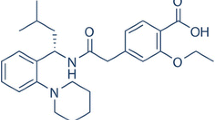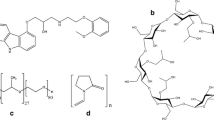Abstract
The studies reported in this work are aimed to elucidate the ternary inclusion complex formation of gemfibrozil (GFZ), a poorly water-soluble drug, with β-cyclodextrin (β-CD) with the aid of auxiliary substances like different grades of povidone(s) (viz. PVP K-29/32, PVP K-40, Plasdone S-630, and Polyplasdone XL), organic base (viz. triethanolamine), and metal ion (viz. MgCl2·6H2O), by investigating their interactions in solution and solid state. Phase solubility studies were carried out to evaluate the solubilizing power of β-cyclodextrin, in association with various auxiliary substances, to determine the apparent stability constant (K C) and complexation efficiency (CE) of complexes. Improvement in K C values for ternary complexes clearly proves the benefit of the addition of auxiliary substances to promote CE. Of all the approaches used, the use of polymer Plasdone S-630 was found to be the most promising approach in terms of optimum CE and K C. GFZ–β-CD (1:1) binary and ternary systems were prepared by kneading and lyophilization methods. The ternary systems clearly signified superiority over binary systems in terms of CE, solubility, K C, and reduction in the formulation bulk. Optimized ternary system of GFZ–β-CD–Plasdone S-630 prepared by using lyophilization method indicated a significant improvement in intrinsic dissolution rate when compared with ternary kneaded system. Differential scanning calorimetry, X-ray diffraction, Fourier transform infrared, scanning electron microscopy, and proton nuclear magnetic resonance were carried out to characterize the binary and optimized ternary complex. The results suggested the formation of new solid phases, eliciting strong evidences of ternary inclusion complex formation between GFZ, β-CD, and Plasdone S-630, particularly for lyophilized products.










Similar content being viewed by others
References
Manca ML, Zaru M, Ennas G, et al. Diclofenac–β-cyclodextrin binary systems: physicochemical characterization and in vitro dissolution and diffusion studies. AAPS PharmSci Tech. 2005;6:64–72.
Challa R, Ahuja A, Khar RK, Ali J. Cyclodextrins in drug delivery: an updated review. AAPS Pharm Sci Tech. 2005;6:E326–38.
Loftsson T, Masson M, Siigurjonsdottir JF. Methods to enhance the complexation efficiency of cyclodextrins. STP Pharma Sci. 1999;9:237–42.
Loftsson T, Brewster ME. Pharmaceutical applications of cyclodextrins. Drug solubilization and stabilization. J Pharm Sci. 1996;85:1017–25.
Ukama K, Otagiri M. Cyclodextrins in drug carrier systems. Chem Rev. 1987;98:2045–76.
Ulu ST. LC determination of gemfibrozil in tablets. Chromatographia. 2006;64:447.
Ain S, Philip B, Pathak K. Preformulative assessment of inclusion complexes of Gemfibrozil, with cyclodextrins. PDA. 2008;62:300–8.
Patel AR, Vavia PR. Effect of hydrophilic polymers on solubilization of fenofibrate by cyclodextrin complexation. J Inc Phenom Macrocycl Chem. 2006;56:247–51.
Loftsson T, Fridriksdottir H. The effect of water soluble polymers on aqueous solubility of drugs. Int J Pharm Sci. 1996;127:293–6.
Higuchi T, Connors A. Phase solubility techniques. Adv Anal Chem Instrum. 1965; 117–211
Loftsson T, Hreinsdottir D, Masson M. The complexation efficiency. J Inc l Phenom Macrocycl Chem. 2007;57:545–52.
Laura SSR, Dominos CF, Francisco JBV. Physicochemical investigation of the effects of water-soluble polymers on vinpocetine complexation with β-cyclodextrin and its sulfobutyl ether derivative in solution and solid state. Eur J Pharm Sci. 2003;20:253–66.
Chowdary KPR, Srinivas SV. Effect of polyvinylpyrrolidone on complexation and dissolution rate of β and hydroxypropyl–β-cyclodextrin complexes of celecoxib. Ind J Pharm. 2006;68:631–4.
Govindarajan R, Nagarsenkar S. Influence of preparation methodology on solid state properties of an acidic drug-cyclodextrin system. J Pharm Pharmacol. 2004;56:725–33.
Aulton M. Pharmaceutical preformulation: the physicochemical properties of drug substances. Pharmaceutics the design of dosage form design. 2nd ed. Philadelphia: Churchill Livingstone; 2002. p. 122–3.
Chowdary KPR, Srinivas SV. Influence of hydrophilic polymer on celecoxib complexation with hydroxypropyl–β-CD. AAPS Pharm Sci Tech. 2006;7:E1–5.
Yamakawa T, Nishimura S. Liquid formulation of a novel non-fluorinated topical quinolone, T-3912, utilizing the synergistic solubilizing effect of the combined use of magnesium ions and hydroxypropyl–β-cyclodextrin. J Cont Release. 2003;86:101–13.
Granero G, Garnero C, Marcela L. The effect of pH and triethanolamine on sulfisoxazole complexation with hydroxypropyl–β-cyclodextrin. Eur J Pharm Sci. 2003;20:285–93.
Fridriksdottir H, Siiguroardottir AM, Ueda H. The effect of water soluble polymers on drug–cyclodextrin complexation. Int J Pharm. 1994;110:169–77.
Mura P, Faucci MT, Bettinetti GP. The influence of polyvinyl pyrrolidone on naproxen complexation with hydroxypropyl β-cyclodextrin. Eur J Pharm Sci. 2001;13:187–94.
A PRODUCT GUIDE Performance Enhancing Products for Pharmaceuticals Available at www.ispcorp.com. Accessed March 8, 2008.
Kollidon BW. Polyvinylpyrrolidone for the pharmaceutical industry 4th edn. BASF; 1998.
Doijad RC, Kanakal MM, Manvi FV. Effect of processing variables on dissolution and solubility of piroxicam: hydroxypropyl–β-cyclodextrin inclusion complexes. Indian J Pharm S. 2007;69:323–6.
Dollo CLC, et al. Improvement in solubility and dissolution rate of 1, 2-dithiole-3-iones upon complexation with β-cyclodextrin and its hydroxypropyl and sulfobutylether derivatives. J Pharm Sci. 1999;88:889–95.
Ahmed GEL. Effect of cyclodextrins on the physico-chemical properties and antimycotic activity of clotrimoxazole. Int J Pharm. 1998;171:111–21.
Kurazumi M, Nambu N, Nagri T. Pharmaceutical interactions in dosage form and processing for Inclusion compounds of non-steroidal anti-inflammatory and other slightly water soluble drugs with β-cyclodextrins in powdered form. Chem Pharm Bull. 1975;23:3062–8.
Veiga F, Fernandes C, Maincent P. Influence of the preparation method on the physicochemical properties of tolbutamide/cyclodextrin binary system. Drug Dev Ind Pharm. 2001;27:523–32.
Fernandes C, Viera MT, Viega F. Physicochemical characterization and in vitro dissolution behaviour of nicardipine-cyclodextrin inclusion compounds. Eur J Pharm Sci. 2002;15:79–88.
Ryan JA. Compressed pellet X-RD monitoring for optimization of crystallinity in lyophilized solids: imipenem: cilastatin sodium case. J Pharm Sci. 1986;75:805–7.
Nalluri BN, Chowdhary KPR, Murthy KVR, et al. Physicochemical characterization and dissolution properties of nimesulide–cyclodextrin binary system. AAPS PharmSci Tech. 2003;4:1–12.
Rao VM, Haslam JL, Stella VJ. Controlled and complete release of model poorly water soluble drug, prednisolone, from hydroxypropylmethylcellulose matrix tablets using SBE–β-cyclodextrin as a solubilizing agent. J Pharm Sci. 2001;129:807–16.
Baboota S, Dhaliwal M, Kohli K, et al. Inclusion complexation of Rofecoxib with dimethyl β-cyclodextrin. J Pharm Sci. 2005;85:226–9.
Erden N, Celebi N. A study of inclusion complex of naproxen with β-cyclodextrin. Int J Pharm. 1988;48:83–9.
Acknowledgements
The authors wish to thank IIT Delhi for providing the facilities for SEM and XRD. We would also like to thank Mr.Yogesh Murti and Mr. Harjeet Singh for their spectral suggestions.
Author information
Authors and Affiliations
Corresponding author
Rights and permissions
About this article
Cite this article
Sami, F., Philip, B. & Pathak, K. Effect of Auxiliary Substances on Complexation Efficiency and Intrinsic Dissolution Rate of Gemfibrozil–β-CD Complexes. AAPS PharmSciTech 11, 27–35 (2010). https://doi.org/10.1208/s12249-009-9350-y
Received:
Accepted:
Published:
Issue Date:
DOI: https://doi.org/10.1208/s12249-009-9350-y




